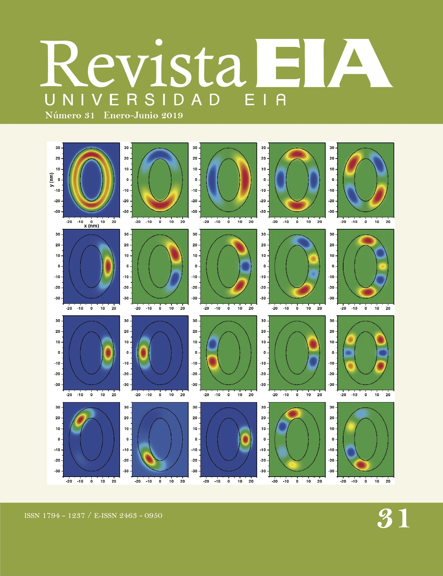Analysis of the students’ interactions and satisfaction during a Collaborative Lab Project
Analysis of the students’ interactions and satisfaction during a Collaborative Lab Project
Barra lateral del artículo
Términos de la licencia (VER)
Declaración del copyright
Los autores ceden en exclusiva a la Universidad EIA, con facultad de cesión a terceros, todos los derechos de explotación que deriven de los trabajos que sean aceptados para su publicación en la Revista EIA, así como en cualquier producto derivados de la misma y, en particular, los de reproducción, distribución, comunicación pública (incluida la puesta a disposición interactiva) y transformación (incluidas la adaptación, la modificación y, en su caso, la traducción), para todas las modalidades de explotación (a título enunciativo y no limitativo: en formato papel, electrónico, on-line, soporte informático o audiovisual, así como en cualquier otro formato, incluso con finalidad promocional o publicitaria y/o para la realización de productos derivados), para un ámbito territorial mundial y para toda la duración legal de los derechos prevista en el vigente texto difundido de la Ley de Propiedad Intelectual. Esta cesión la realizarán los autores sin derecho a ningún tipo de remuneración o indemnización.
La autorización conferida a la Revista EIA estará vigente a partir de la fecha en que se incluye en el volumen y número respectivo en el Sistema Open Journal Systems de la Revista EIA, así como en las diferentes bases e índices de datos en que se encuentra indexada la publicación.
Todos los contenidos de la Revista EIA, están publicados bajo la Licencia Creative Commons Atribución-NoComercial-NoDerivativa 4.0 Internacional
Licencia
![]()
Esta obra está bajo una Licencia Creative Commons Atribución-NoComercial-NoDerivativa 4.0 Internacional
Contenido principal del artículo
Resumen
The main purpose of this paper is to present the students' interactions and satisfaction in a Collaborative Lab Project supported by a Teaching Assistant System-TASystem. The goal of the developed TASystem is twofold: a) to assist the instructors with the design of collaborative learning activities in Learning Management Systems-LMS and b) to help the students when performing this type of activities in these systems. The TASystem was embedded into the LMS Moodle. In order to carry out this study, a research methodology was defined. Students from the School of Engineering at the Universidad del Valle-UNIVALLE (Colombia) took part in the research study. The mainly presented results in this research study showed that the students were motivated to interact and collaborate with their classmates in a small group level. And that most of the students were satisfied when using the TASystem in Moodle.
Descargas
Detalles del artículo
Leovy Echeverría Rodríguez, Universidad Pontificia Bolivariana
Ingeniera de Sistemas por la Universidad Industrial de Santander, Especialista en Gerencia de Sistemas de Información por la Universidad del Norte (Colombia), Magister y doctora en Ingeniería Informática y Telecomunicaciones por la Universidad Autónoma de Madrid (España). Docente interna de la Facultad de Ingeniería Informática de la Universidad Pontificia Bolivariana Seccional Montería (Colombia). Integrante del grupo de investigación ITEM de la Universidad Pontificia Bolivariana.Ruth Cobos, Universidad Autónoma de Madrid
Doctora en Ingeniería Informática. Profesora del Departamento de Ingeniería Informática de la Universidad Autónoma de Madrid-UAM (España). Integrante del grupo de investigación GHIA de la UAM.Liliana Machuca, Universidad del Valle
Profesora Asistente de la Escuela de Ingeniería de Sistemas y Computación de la Facultad de Ingeniería de la Universidad del Valle (Colombia).Referencias (VER)
Abraham, D. and Yacef, K. (2002) ‘Adaptation in the Web-based Logic-ITA’, Lecture Notes in Computer Science (including subseries Lecture Notes in Artificial Intelligence and Lecture Notes in Bioinformatics), 2347, pp. 456–461. Available at: https://www.scopus.com/inward/record.uri?eid=2-s2.0-78549275573&partnerID=40&md5=a372e0d7c4ceee9ef76db65b5a5bf2b6.
Al-Ajlan, A. and Zedan, H. (2008) ‘Why Moodle’, 2008 12th IEEE International Workshop on Future Trends of Distributed Computing Systems, pp. 58–64. doi: 10.1109/FTDCS.2008.22.
Blackboard (2015). Available at: http://es.blackboard.com/sites/international/globalmaster/ (Accessed: 1 January 2015).
Van Boxtel, C., Van der Linden, J. and Kanselaar, G. (2000) ‘Collaborative learning tasks and the elaboration of conceptual knowledge’, Learning and Instruction, 10(4), pp. 311–330. doi: 10.1016/S0959-4752(00)00002-5.
Claroline (2015). Available at: http://www.claroline.net/ (Accessed: 1 January 2015).
Claros, I. et al. (2014) ‘Towards a Collaborative Pedagogical Model in MOOCs’, in 2014 IEEE Global Engineering Education Conference (EDUCON), pp. 905–911.
Claros, I., Echeverria, L. and Cobos, R. (2015) ‘Towards MOOCs scenaries based on collaborative learning approaches’, in Global Engineering Education Conference (EDUCON), 2015 IEEE, pp. 989–992. doi: 10.1109/EDUCON.2015.7096093.
Costa, C., Alvelos, H. and Teixeira, L. (2012) ‘The Use of Moodle e-learning Platform: A Study in a Portuguese University’, Procedia Technology, 5, pp. 334–343. doi: 10.1016/j.protcy.2012.09.037.
Diez, F. and Cobos, R. (2008) ‘A case study of a cooperative learning experiment in Artificial Intelligence’, Computer Applications in Engineering Education, 15(4), pp. 308–316. doi: 10.1002/cae.20114.
Dillenbourg, P. et al. (1996) ‘The evolution of research on collaborative learning’, Learning, pp. 189–211. Available at: http://citeseerx.ist.psu.edu/viewdoc/download?doi=10.1.1.92.2555&rep=rep1&type=pdf.
Dillenbourg, P. (1999) ‘What do you mean by â€TM collaborative learning ’?’, Collaborative learning Cognitive and computational approaches, 1(6), pp. 1–15. doi: 10.1.1.167.4896.
Dokeos (2015). Available at: http://www.dokeos.com/ (Accessed: 12 June 2017).
Echeverria, L. (2017) UNA PROPUESTA DE UNA PLATAFORMA DE APRENDIZAJE BASADA EN ESCENARIOS COLABORATIVOS PARA LA REALIZACIÓN DE EXPERIENCIAS DE APRENDIZAJE MIXTO CON SOPORTE A LA INVESTIGACIÓN, Tesis doctoral. Universidad Autónoma de Madrid.
Echeverría, L. (2011) Motivation Booster based on the monitoring of users’ progress in collaborative learning scenarios. Trabajo Fin de Master, Universidad Autónoma de Madrid.
Echeverría, L. et al. (2017) ‘Using collaborative learning scenarios to teach programming to non-CS majors’, Computer applications in engineering education, 25(3), pp. 1–13.
Echeverría, L. and Cobos, R. (2015) ‘Designing the assessment of the collaborative learning process in LMS courses’, in Proceedings of the 2015 IEEE 19th International Conference on Computer Supported Cooperative Work in Design (CSCWD), pp. 218–223.
Echeverría, L., Cobos, R. and Buendía, S. (2013) ‘A Teaching Assistant for task and assessment management in Collaborative Learning Scenarios’, in Octavo Congreso Colombiano de Computación-8CCC 2013, pp. 26–29.
Echeverría, L., Cobos, R. and Morales, M. (2013) ‘Designing and evaluating collaborative learning scenarios in Moodle LMS Courses’, in Proceedings of the 10th International Conference on Cooperative Design, Visualization, and Engineering, pp. 61–66.
Koschmann, T. (2008) ‘Paradigm shifts and instructional technology: An introduction’, Radiologic technology, 80(1), pp. 67–74. Available at: http://www.ncbi.nlm.nih.gov/pubmed/23032751.
Kumar, S., Gankotiya, A. K. and Dutta, K. (2011) ‘A comparative study of moodle with other e-learning systems’, in ICECT 2011 - 2011 3rd International Conference on Electronics Computer Technology, pp. 414–418. doi: 10.1109/ICECTECH.2011.5942032.
Lesta, L. and Yacef, K. (2002) ‘An intelligent teaching assistant system for Logic’, Intelligent Tutoring Systems. Available at: http://link.springer.com/chapter/10.1007/3-540-47987-2_45.
Martín, M. et al. (2008) ‘Generating teacher adapted suggestions for improving distance educational systems with SIgMa’, in Proceedings - The 8th IEEE International Conference on Advanced Learning Technologies, ICALT 2008, pp. 449–453. doi: 10.1109/ICALT.2008.227.
Moodle (2015). Available at: https://moodle.org/ (Accessed: 1 January 2015).
Perikos, I., Grivokostopoulou, F. and Hatzilygeroudis, I. (2011) ‘TEACHING ASSISTANT TOOLS FOR NL TO FOL CONVERSION’, in IADIS International Conference e-Learning, pp. 337–344.
Pifarre, M. and Cobos, R. (2010) ‘Promoting metacognitive skills through peer scaffolding in a CSCL environment’, International Journal of Computer-Supported Collaborative Learning, 5(2), pp. 237–253. doi: 10.1007/s11412-010-9084-6.
Ploetzner, R. et al. (1999) ‘Learning by Explaining to Oneself and to Others’, Collaborative-learning; Cognitive and Computational Approaches, pp. 103–121.
Queirós, R. and Leal, J. (2012) ‘PETCHA: a programming exercises teaching assistant’, Proc. ITiCSE 2012, pp. 192–197. doi: 10.1145/2325296.2325344.
Risko, E. F. et al. (2013) ‘The collaborative lecture annotation system (CLAS): A new TOOL for distributed learning’, IEEE Transactions on Learning Technologies, 6(1), pp. 4–13. doi: 10.1109/TLT.2012.15.
Rivera, D. and Machuca, L. (2014) ‘A Virtual Assistant Architecture to support the delivery of texts in languages teaching - learning processes’, Ingeniería y Competitividad, 16(2), pp. 155–164.
Sakai (2018). Available at: https://sakaiproject.org/ (Accessed: 12 July 2018).
Smith, L. and Macgregor, J. T. (1992) What is Collaborative Learning ?, Collaborative Learning: A Sourcebook for Higher Education.
Vélez, J. (2009) Pelican. Una plataforma para el diseño y desarrollo de escenarios de aprendizaje colaborativo. Soporte a los aspectos dinámicos. Universidad Nacional de Educación a Distancia.
Villegas, L. E. M. and Carrillo, P. J. R. (2011) ‘Experiences in developing an e-learning system for language learning and teaching’, in 2011 6th Colombian Computing Congress (CCC). IEEE, pp. 1–6. doi: 10.1109/COLOMCC.2011.5936281.
Webb, N. M. (1991) ‘Task-Related Verbal Interaction and Mathematics Learning in Small Groups’, Journal for Research in Mathematics Education, 22(5), pp. 366–389. doi: 10.2307/749186.
Yacef, K. (2005) ‘The Logic-ITA in the classroom: a medium scale experiment’, International Journal of Artificial Intelligence in Education (IJAIED), 15(1), pp. 41–60.
Artículos similares
- Juan Carlos Orozco-Vásquez, Juan Felipe Grisales-Díaz, Sebastián Roldán-Vasco, Claudia Patricia Ossa-Orozco, Luz Marina Restrepo-Múnera, María Elena Moncada Acevedo, Diseño y construcción de un equipo estimulador de campo eléctrico tipo capacitivo para estimulación celular , Revista EIA: Vol. 17 Núm. 34 (2020)
- Darío Naranjo-Fernández, Alternativas de vertimiento y reúso de aguas de producción de yacimientos convencionales y no convencionales de crudo y gas en Colombia , Revista EIA: Vol. 20 Núm. 39 (2023): Tabla de contenido Revista EIA No. 39
También puede {advancedSearchLink} para este artículo.


 PDF
PDF
 FLIP
FLIP




